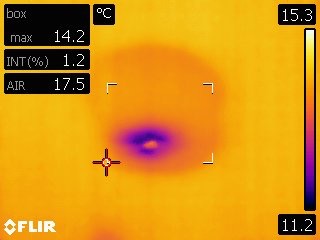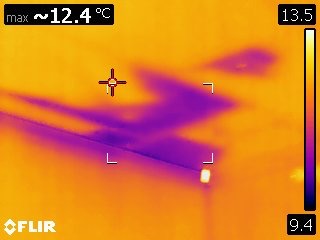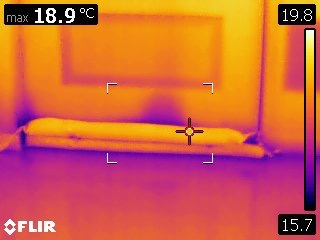Moisture
Infrared Thermal Imaging can assist in identifying abnormal moisture in walls, ceilings and floors before the visible signs like staining, efflorescence (salt) and flaking paint or render become evident. Water can cause the premature deterioration of many building products and sadly once you can see the tell-tale signs it’s usually too late, the damage is done.
The evaporation of water is a cooling process and this leaves distinctive (and easy to detect) thermal patterns on surfaces identifying areas where we can then conduct more detailed surface contact testing with electronic moisture meters.

Thermal pattern showing water leak to ceiling lining
Energy Efficiency
Insulation
Many building designs and construction methods restrict access to voids and cavities making it difficult to determine if insulation is protecting the interior effectively. Infrared imaging can identify abnormal thermal patterns to walls and ceilings, revealing where insulation has been damaged, disturbed or not properly installed.

Section of ceiling where insulation has been disturbed.
Inefficient air-conditioning systems
Many air-conditioning and heating systems rely on flexible ducting to transfer air to the internal rooms. Ducting loses its efficiency if compressed when installed and is susceptible to deterioration over time, as the outer insulation layer can fall away and taped joins can separate allowing conditioned air to escape.

Abnormal thermal patterns indicating heat escape from flexible ducting in a sealed bulkhead.
Ineffective Door and Window Seals
Preventing conditioned air escaping or external air from entering a building by identifying where windows and doors are not sealing correctly can decrease power usage and energy costs and potentially prolong the service life of heating and cooling units.

Cool air entering under a door
